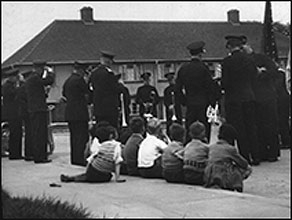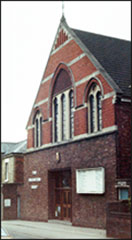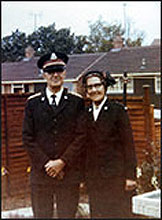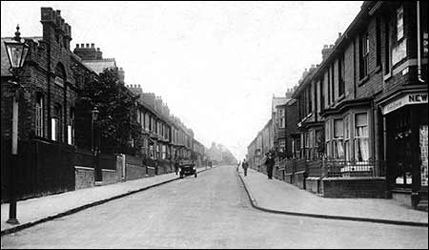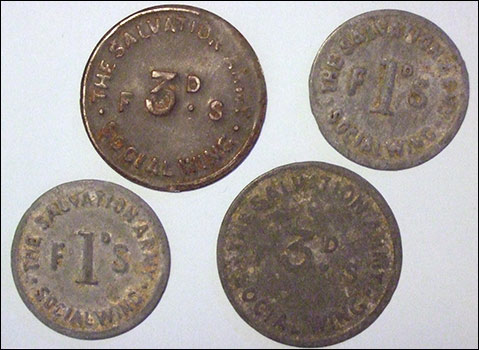|
||||||
| Extracted from the Centenary Booklet |
||||||
|
Salvation Amy - 100 years
|
||||||
|
Corps 432 – 1883-1983
|
||||||
|
The Wellingborough & Kettering News – 10th March 1883 “The Wellingborough Corps of the Salvation Army made a grand attack on this village on Sunday last. The assault was accompanied by a flourish of trumpets, fiddles and tambourines and a grand procession through the village at two o’clock at which time the streets were thronged. The Army and camp followers bivouaced for the afternoon and evening at the New Hall, as many as could taking shelter inside but both in the afternoon and at the evening roll call hundreds had to remain outside. On Monday evening the Army again fell in near the church and marched to the small mission room on Higham Hill where more than would have filled the room three times over were in waiting. On Sunday and Monday hundreds of persons went from Higham to see the procession. A further meeting was held last night and it is intended to start a local corps.” The War Cry - 20th June 1883 “The Village of Rushden is going up, although it has met with some up-hill work. For some time past Sergeant Rockingham has been working it himself, but the work has increased so that it must have someone to devote the whole of their time to it. Last Sunday Lieutenant Fleet took command and we had good meetings all day. At night the people were spell-bound while some soldiers were speaking and there was deep conviction of sin in many hearts.” The War Cry – 30th June 1883 Rushden during sixteen weeks has taken ninety-seven prisoners, has now eighty-six soldiers; sold thirty-four dozen “War Crys” last week. They are attacking Higham; got a barn lent; no seats, but place jammed, though everybody standing; believing for a smash. The Wellingborough & Kettering News – 6th October 1883 “On Feast Wednesday, the Corps of this Village had a grand field day and presentation of colours. In the afternoon a grand parade was called when a strong muster of the 432nd (Rushden) Corps assembled added to which a strong contingent arrived from Wellingborough. At the meeting in the evening the hall was quite full, Major Fawcett started a piece which was sung as a solo, duet and chorus ‘Waiting for the great White Throne’ and the singing of this and several of the pieces that followed would have done credit to any place of worship and was a great improvement on what one often hears at places of more pretentions. Major Fawcett also presented the colours and gave the history of the Salvation Army Flag. He said he hoped the Corps would set as much store by their colours as did the army of Her Majesty and he hoped they would be carried to every street in the neighbourhood. Captain Cousins suitably replied on receipt of the colours as did Colour Sergt. Field, who received them.” Salvation Army Colours
“Yellow star, red and blue Blood and Fire, through & through That’s the flag for me and you The flag of the dear old Army”. Services were held at the New Hall for a time and then at the Temperance Hall but were given notice to quit and so began fund raising to build their own barracks. A piece of land in Queen Street was purchased from Mr Thomas Lilley (of Lilley & Skinner, London). The estimated cost was £600 and the local Corps was to raise £150 towards this. The Wellingborough & Kettering News – 7th December 1888
On Monday 400 attended a meeting and at 7 o’clock a United March was followed by a meeting when the address was given by Mrs Bramwell Booth. The Wellingborough & Kettering News – March 1890 “On Sunday night Captain of the local corps of the Salvation Army informed his hearers that he and his fellow officer had made up their minds to “flit” i.e. to leave their lodgings and set up housekeeping for themselves. This however was a step of considerable magnitude, seeing that all the goods and chattels of which they could boast were two cups and an equally large number of saucers. This being the case he invited all those who were of an overplus of worldly goods to forward them to the open-air meeting to be held near the Vestry Hall on Wednesday. The appeal was not in vain for on the evening in question there were deposited in the ring, an iron bedstead, a table, two chairs, some plates and a half pint glass, a coal hod, lamp, pieces of carpet, a saucepan and a mousetrap!” In 1906 Herbert Booth, son of the Founder visited Rushden and the following year on July 19th his father, in a white motor car, made a short stop at the green. Men came out from the factories and children from the schools – and the Salvation Army Band was playing. On 11th October 1947 at 2.45pm Mr C W Horrell opened their new hall. After much fund raising they had purchased and moved to the old Congregational Church in Church Street, where they still reside today.
*Having built extensive additions, in 2007 they are now running a very successful ‘Charity Shop’ adjoining their church, an equally successful café called the “Olive Branch”. The day nursery which they have been running has announced it will close by the end of this year (2007). The funds raised help in their magnificent works in the community and further a field.
|
||||||
